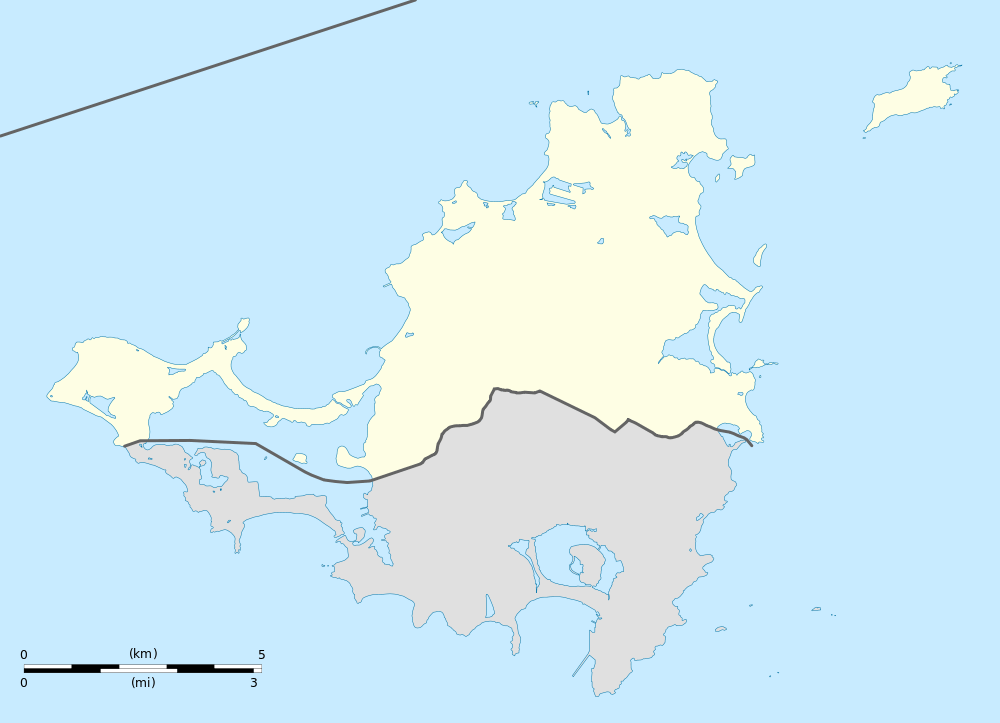Marigot, Saint Martin
| Marigot | |
|---|---|
|
Marigot | |
 Marigot | |
| Coordinates: 18°04′23″N 63°04′56″W / 18.0731°N 63.0822°WCoordinates: 18°04′23″N 63°04′56″W / 18.0731°N 63.0822°W | |
| Country | France |
| Overseas collectivity | Saint Martin |
| Population (2006) | |
| • Total | 5,700 |

Marigot is the main town and capital on the French side of the Caribbean island of Saint Martin.
Population
As of 2006, it has 5,700 inhabitants.
Geography
Marigot is located on the west coast of the island of St. Martin. It extends from the coast to the west, along the Bay of Marigot and the hills of the interior of the island to the east. On the south-west it is bounded by the Simpson Bay.
Climate
This area typically has a pronounced dry season. According to the Köppen Climate Classification system, Marigot has a tropical savanna climate, abbreviated "Aw" on climate maps.[1]
| Climate data for Marigot | |||||||||||||
|---|---|---|---|---|---|---|---|---|---|---|---|---|---|
| Month | Jan | Feb | Mar | Apr | May | Jun | Jul | Aug | Sep | Oct | Nov | Dec | Year |
| Average high °C (°F) | 28 (83) |
28 (83) |
28 (83) |
29 (84) |
30 (86) |
31 (88) |
31 (88) |
31 (88) |
31 (88) |
31 (87) |
29 (85) |
28 (83) |
29.6 (85.5) |
| Average low °C (°F) | 24 (75) |
24 (75) |
24 (75) |
25 (77) |
26 (78) |
27 (80) |
27 (80) |
27 (80) |
27 (80) |
27 (80) |
26 (78) |
24 (76) |
25.7 (77.8) |
| Average precipitation mm (inches) | 74 (2.9) |
48 (1.9) |
43 (1.7) |
79 (3.1) |
99 (3.9) |
71 (2.8) |
84 (3.3) |
114 (4.5) |
117 (4.6) |
99 (3.9) |
117 (4.6) |
91 (3.6) |
1,036 (40.8) |
| Source: Weatherbase [2] | |||||||||||||
Transport
The city is served by Princess Juliana International Airport as well as L'Espérance Airport. There is a ferry to Blowing Point, Anguilla.
History and features
Originally a fishing village on a swamp for which it was named, Marigot was made capital during the reign of King Louis XVI, who built Fort St. Louis on a hill near Marigot Bay. Today, that building is the most important in Marigot.
Marigot is typical of Caribbean towns, with gingerbread houses and sidewalk bistros. Market days are every Wednesday and Saturday morning, where one can find everything from coconuts, avocados, sweet potatoes and plenty of other tropical fruits and vegetables, all kinds of spices and fresh fish, to fine batik wraps, local arts, crafts and paintings. In 1998, Speed 2 shot the finale scene here where the Seabourn Legend hits the island.
See also
External links
- About Saint Martin Tourist Guide
- www.geographia.com, St Martin
References
- ↑ Climate Summary for Marigot, Saint Martin
- ↑ "Weatherbase: Historical Weather for The Valley, Anguilla". Weatherbase. 2011. Retrieved on November 24, 2011.










